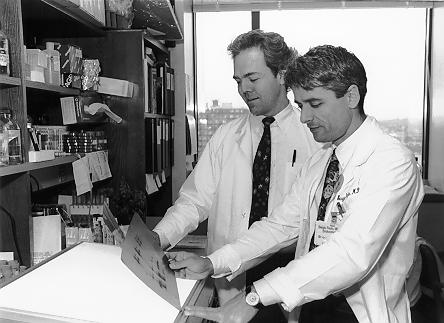
Drs. MacRae Linton (left) and Sergio Fazio are investigating a protein they believe is linked to atherosclerosis.
Investigators eye protein shortage as atherosclerosis factor
Two VUMC researchers are shedding new light on why the human body's mechanism for processing cholesterol can sometimes shut down, a condition thought to be a major factor in atherosclerosis.
They believe a shortage of the protein apoliprotein E (Apo E) is a contributing factor in the breakdown of cholesterol processing.
"Apo E is a protein that, for a long time, has been known to be important for clearing cholesterol particles from the bloodstream," said Dr. MacRae F. Linton, assistant professor of Medicine and Pharmacology.
When blood cholesterol levels are high, cholesterol-containing lipoproteins enter the artery wall. Macrophages are attracted to the artery wall to clean up the cholesterol. Over time, however, the macrophages themselves become overloaded with fat droplets and shut down. When this happens they are called foam cells.
These foam cells are thought to be one of the chief factors in initiating atherosclerosis, which results in plaque build-up in the artery wall, eventually causing blockage.
The reason some macrophages become foam cells may be because they do not contain enough Apo E, concluded Linton and Dr. Sergio Fazio, assistant professor of Medicine and Pathology.
The two VUMC researchers have been studying the role of Apo E secretion by macrophages with the goal of finding a way to manipulate the buildup of these foam cells.
Ninety percent of the human body's Apo E is made by the liver, but it is also made in cells throughout the body. The other important cell type that makes Apo E is the macrophage itself, which is a white blood cell that moves throughout tissues to gobble up debris, invading organisms and dying cells.
Linton and Fazio have recently demonstrated that Apo E slows the macrophage's transformation into foam cells. This may be due to Apo E's ability to drive cholesterol out of the macrophage.
"If they can get better at driving out the cholesterol, then it will take much longer for them to become foam cells which clog the flow of blood," said Fazio.
A reduction in the amount of foam cells in the arteries may slow or prevent the development of atherosclerosis.
"Our interest in Apo E is its role in clearing cholesterol from the macrophage, which make a lot of Apo E," said Linton.
Linton and Fazio began studying the protein in in vivo models in which mice had been engineered not to make Apo E. These mice then developed very high cholesterol and severe atherosclerosis which they are not normally prone to.
Because macrophages are produced in the bone marrow, Linton and Fazio, in a previous study, gave the mice transplants that contained Apo E.
"Just a small amount of Apo E was enough to cure these mice and plasma cholesterol normalized within a couple of weeks," said Linton. "It was dramatic because we delivered a gene that was missing and prevented atherosclerosis."
The goal of the study, however, was to investigate the role of the Apo E gene in macrophages. Because the cholesterol levels were corrected in the reconstituted mice, there was no way to draw any conclusions about the local role of Apo E.
So Linton and Fazio did the opposite experiment.
"Working from a normal mouse we gave it Apo E-deficient bone marrow so that it would have a normal liver that produced normal amounts of Apo E, but did not produce Apo E in macrophages," said Fazio.
What they found was that the Apo E-deficient mice produced 10 times the amount of lesions on the arteries than did the mice with bone marrow that contained Apo E.
The macrophages in the Apo E-deficient mice could not get rid of the cholesterol that they had taken in, becoming foam cells much more rapidly then the normal mice.
The macrophages that were at first sent by the body to clean up the cholesterol became part of the process of atherosclerosis.
"That was clear evidence that macrophages can use Apo E as one mechanism to control the amount of cholesterol in the cells," said Fazio.
Linton and Fazio's work was recently recognized at the American Heart Association Scientific Sessions in New Orleans by being awarded the Irving H. Page award for atherosclerosis research.













